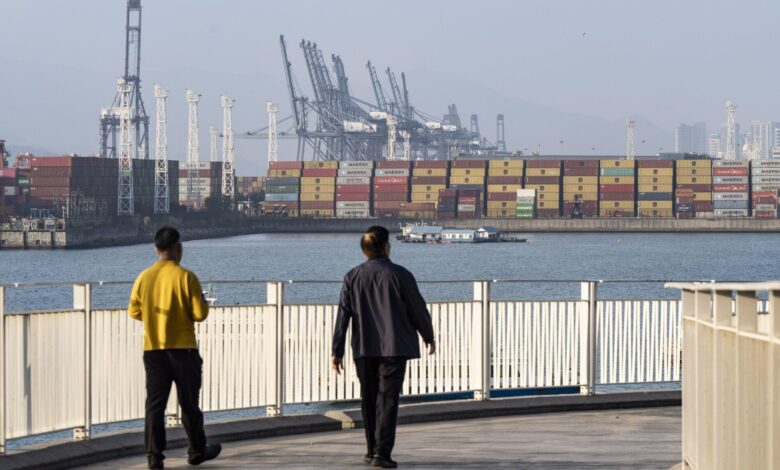Why Biden is escalating Donald Trump’s China tariffs

US PRESIDENT Joe Biden is stepping up tariffs on products from China in response to what American officials call unfair trade practices. After a review of the increased tariffs his predecessor, Donald Trump, imposed on Chinese imports, the Biden administration said in May that it would maintain those and add more of its own. Both administrations have justified the moves by saying China’s industrial and trade policies put US competitors at a disadvantage.
Among the Chinese goods targeted by the new US levies are electric vehicles (EVs), batteries and semiconductors – the lifeblood of a greener, more artificial intelligence (AI) filled digital future. Meanwhile, the European Union said it would impose additional tariffs on EVs shipped from China starting in July, taking levies to as much as 48 per cent. The decision followed an investigation of whether Chinese government subsidies violated trade rules. In both cases, imposing additional trade barriers carries the risk that China will respond in kind.
Here’s a guide to the key US tariff hikes, with credit to Kyle Handley, associate professor of economics at the University of California San Diego, for calculating the value of each category.
Semiconductors
US tariff change: From 25 to 50 per cent in 2025
Value of 2023 imports from China: US$504 million
Motivation: Both China and the US are determined to improve their position in computer chip manufacturing. In addition to investing US$52.7 billion to ramp up its domestic semiconductor industry, the US government has deployed export controls to contain China’s ambitions. These new levies aim to counter China’s aggressive push in so-called legacy chips, which are components of an older generation that nevertheless remain essential to the global economy. The levies come after a formal review of US supply chains for those semiconductors and alongside a similar survey by the EU. A big longer-term worry is how China might use a technology edge for military purposes.
GET BT IN YOUR INBOX DAILY

Start and end each day with the latest news stories and analyses delivered straight to your inbox.
Risks: The US may be overestimating China’s capacity to produce legacy chips. China could weaponize them by increasing costs “after getting companies and consumers hooked”, according to Emily Benson, director of the Project on Trade and Technology at the Center for Strategic & International Studies.
Critical minerals
US tariff change: From no tariff to 25 per cent in 2024 and 2026
Value of 2023 imports from China: US$783 million
Motivation: Tariffs on several critical minerals such as cobalt and zinc – key inputs for making EVs – will go from zero to 25 per cent. Most will take effect this year, while the duty for natural graphite will come into force in 2026. China’s investments in building an industrial network to source the materials needed to build a less carbon-intensive economy have made it the undisputed leader in critical minerals. An overdependence on any single country makes manufacturers vulnerable to supply disruptions, and with China, there’s the additional risk of strained ties snowballing. In December, China imposed export controls on natural graphite.
Risks: Almost one-third of the weight of an EV comes from graphite, and the US has less than 1 per cent of the world’s supply versus China’s 90 per cent. The delay in imposing the tariff on it may provide time to fix the sourcing imbalance, according to Gracelin Baskaran, the director of the Project on Critical Minerals Security at the Center for Strategic and International Studies. One result of the tariffs overall could be higher supply-chain costs for US automakers, she said. But she added that it’s difficult to predict the impact considering that minerals can be rerouted to avoid the tariffs.
Electric vehicles
US tariff change: From 25 to 100 per cent in 2024
Value of 2023 imports: US$385 million
Motivation: Quadrupling EV tariffs will eliminate any hope Chinese producers had of cracking the US market, which was already virtually impenetrable given the previous tariff. The Biden administration wants to ensure Chinese imports do not flood into the US, where domestic carmakers fear cheap, subsidised and competitive vehicles from China would stunt their share of a growing market. That’s started to happen in Europe.
Risks: Chinese automakers may set up shop in Mexico in part with the hope of exporting cars from there to the US to avoid the tariffs; the Biden administration said it’s watching for such moves and considering a ban, for national security reasons, on internet-connected Chinese cars that could collect sensitive data about US citizens and infrastructure. The US tariff change poses the risk to Europe that China will start dumping low-priced EVs into auto-producing economies such as Germany, France and Italy.
Lithium-ion EV and non-EV batteries
US tariff change: From 7.5 to 25 per cent in 2024 to 2026
Value of 2023 imports: US$13.1 billion
Motivation: US officials worry that Chinese overcapacity in the battery industry will impede the development of US capacities in a field that is critical to the green transition over the next decade or two. The tariffs are aimed at encouraging investments in the US battery industry and the sourcing of raw materials outside of China.
Risks: Among the risks analysts cite is the potential for setbacks in US efforts to reduce carbon emissions. According to Joseph Webster, a senior fellow at the Atlantic Council’s Global Energy Center, Chinese exports of lithium-ion batteries are important for grid storage of intermittent solar power. “US efforts to decarbonise its grid could slow down,” he said.
Steel and aluminium
US tariff change: From 7.5 to 25 per cent in 2024
Value of 2023 imports: US$1.27 million
Motivation: Of all the new or hiked tariffs, trade observers consider these to be the most politically motivated – given the number of swing states in the Rust Belt where Biden is running behind in polls against Trump. The American Iron and Steel Institute applauded Biden’s decision as a way to counter China’s trade practices. But the impact on domestic aluminium producers will be minimal because China accounts for just 2 per cent of US imports, according to Moody’s Ratings, which added that the fallout on US steel companies will not be large either.
Risk: Higher tariffs will boost production costs for automakers, which use a lot of the metals, so consumers might wind up on the losing end.
Ship-to-shore cranes
US tariff change: From no tariff to 25 per cent in 2024
Value of 2023 imports: US$17.5 million
Motivation: Espionage by China using its civilian maritime might has risen on the US government’s list of concerns, given the vast assets and infrastructure the country controls in global shipping. That includes state-controlled container carriers, port terminal operators, shipbuilders and crane producers.
Risks: China is the dominant maker of those giant cranes used to lift containers in ports around the world, so trying to find producers elsewhere may make the process more complicated and costlier. American ports forced to pay extra would likely pass those costs along to cargo carriers, which in turn would raise fees on importers and exporters. BLOOMBERG


 Bonuses for new players
Bonuses for new players